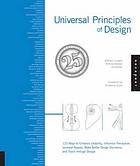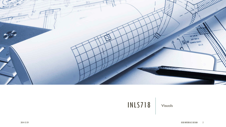from analysis to design requirements

Read these to prepare for class discussion
-
Universal principles of design
The Principle of Constancy, 58 -
Universal principles of design
The Principle of Control, 64 -
a relevant article from the Nielsen Norman Group
Mini-IA: Structuring the Information About a Concept -
Lindgaard, G., et al. (2006).
User needs analysis and requirements engineering:
Theory and practice.
Interacting with Computers, 18(1), 47-70.
[PDF]
Read section 2, pages 50-56 only -
Hartson, H. R. (2003).
Cognitive, physical, sensory, and functional affordances in interaction design.
Behaviour & Information Technology, 22(5), 315-338.
[PDF]
[top]
Optional readings which may come up in class discussions
Valacich, J.S., Parboteeah, D.V., & Wells, J.D. (2007).
The online consumer's hierarchy of needs.
Communications of the ACM, 50(9), 84-90.
[PDF]
Graefe, T. M. (1998).
Transforming representations in user-centered design.
In Wood, L. E. (Ed.),
User Interface Design: Bridging the Gap from User Requirements to Design.
Boca Raton, CRC Press, 57-79.
[QA76.9.U83 U837 1998]
McLaughlin, L. (2004).
What's next in Web search?.
IEEE Distributed Systems Online, 5(11).
[PDF]
Useful, but not available online
Erickson, T. D. (1990).
Creativity and design: introduction.
In Laurel, B. (Ed.),
The Art of human-computer interface design.
Reading, MA: Addison-Wesley, 1-4.
[QA76.9 .H85 A78 1990]
Mountford, S. J. (1990).
Tools and techniques for creative design.
In Laurel, B. (Ed.),
The Art of human-computer interface design.
Reading, MA: Addison-Wesley, 17-30.
[QA76.9 .H85 A78 1990]
von Oech, R. (1990).
Tools and techniques for creative design.
In Laurel, B. (Ed.),
A Whack on the Side of the Head: How You Can Be More Creative Rev. ed.
New York: Warner Books.
[BF408 .V58 1990]
Some specialized hci-related databases and search engines
-
ACM Digital Library.
(Includes ACM publications, as well as a selection of computer science publications from other professional associations.) Access provided by UNC libraries. - Best Ever HCI Search.
-
Business Source Premier.
(Indexes materials in the business literature; narrow tsystems-related materials first.) Access provided by UNC libraries. -
INSPEC.
(A large general database in physics, electrical and mechanical engineering, computers and related physical sciences; narrow search tHCI-related materials first.) Access provided by UNC libraries. -
Perlman, G. (current).
HCI Bibliography: Human-Computer Interaction Resources. - Web Design and Development Search Engine.
Some sources of guidelines
- Mac OS X Human Interface Guidelines.
- SAP User Experience Community
- User Experience and Design > Design > Design Concepts > Design Principles. IBM.
-
Fowler, S. L., & Stanwick, V. R. (1995).
The GUI Style Guide.
Boston: AP Professional.
[QA76.9 .U83 F69 1995] -
Johnson, J. (2000).
GUI Bloopers: Don'ts and Do's for Software Developers and Web Designers.
San Francisco: Morgan Kaufmann.
[QA76.9 .U83 J63 2000]
-
Mayhew, D. J. (1992).
Principles and Guidelines in Software User Interface Design.
Englewood Cliffs, NJ: Prentice Hall.
[QA76.9 .U83 M39 1992] -
Raskin, J. (1996).
Wanted: for crimes against the interface: thoughts on an HCI poster.
interactions, 3(6), 70-76.
[PDF] -
Reeves, L. M., et al. (2004).
Guidelines for multimodal user interface design.
Communications of the ACM, 47(1), 57-59.
[PDF]
Some sources of guidelines and other readings specific to web applications
-
Baxley, B. (2003).
Making the Web Work: Designing Effective Web Applications.
New Riders.
[TK5105.888 .B395 2002]
-
Brinck, T., Gergle, D., & Wood, S. (2002).
Designing Web Sites that Work.
Morgan Kaufmann.
[TK5105.888 .B763 2002]
-
Farkas, D. K., & Farkas, J. B. (2002).
Principles of Web Design.
New York: Longman.
[TK5105.888 .F36 2002] -
Hammerich, I. (2002).
Developing Online Content: The Principles of Writing and Editing for the Web.
New York: Wiley.
[TK5105.888 .H36 2002] -
Kahn, P., & Lenk, K. (1998).
Principles of typography for user interface design.
interactions, 5(6), 15-29.
[PDF] -
Lynch, P. J., & Horton, S. (2008).
Web Style Guide: Basic Design Principles for Creating Web Sites. 3rd ed.
New Haven: Yale University Press.
[online] and [TK5105.888 .L96 2008] -
Manber, U., Patel, A., & Robison, J. (2000).
Experience with personalization on Yahoo!
Communications of the ACM, 43(8): 35-39.
[PDF] -
Marcus, A. (2004).
Branding 101 [Fast Forward].
interactions, 11(5), 14-21.
[PDF] - National Cancer Institute. (n.d.) Research-Based Web Design & Usability Guidelines.
- Nielsen, J. (1997). How to Write for the Web. Jakob Nielsen's Alertbox.
- Nielsen, J. Writing for the web: Research on how users read on the Web and how authors should write their Web pages. Jakob Nielsen's Alertbox.
- Nielsen, J. (1999, October 3). Ten good deeds in Web design. Jakob Nielsen's Alertbox.
-
Nielsen, J. (2000).
Designing Web Usability.
Indianapolis: New Riders.
[TK5105.888 .N55 2000] -
Nielsen, J., & Tahir, M. (2002).
Homepage Usability: 50 Websites Deconstructed.
Indianapolis: New Riders.
[HD30.37 .N54 2002]
Homepage guidelines, p7-35 - Nielsen, J. (2001). 113 Design Guidelines for Homepage Usability
-
Pearrow, M. (2000).
Web Site Usability Handbook.
Rockland, MA: Charles River Media.
[TK5105.888 .P4223 2000] -
Powell, T. (2000).
Web Design: The Complete Reference.
Berkeley, CA: Osborne/McGraw-Hill.
[e-book] or [TK5105.888 .P617 2000] -
Sklar, J. (2000).
Principles of Web Design.
Cambridge, MA: Thomson Learning.
[TK5105.888 .S583 2000] -
Van Duyne, D. K., Landay, J. A., & Hong, J. I. (2003).
Design of Sites: Patterns, Principles and Processes for Crafting a Customer-Centered Web Experience.
Boston: Addison-Wesley.
[TK5105.888 .V36 2003]
-
Veen, J. (2001).
The Art & Science of Web Design.
Indianapolis: New Riders.
[TK5105.888 .V43 2001] -
Williams, R., & Tollett, J. (2000).
The Non-Designer's Web Book. 2nd ed.
Berkeley: Peachpit Press.
[TK5105.888 .W5536 2000]
Particularly Parts 3 and 4.
Web guidelines for accessibility - related readings
-
Chisholm, W., Vanderheiden, G., & Jacobs, I. (2001).
Web content accessibility guidelines 1.0.
interactions, 8(4), 35-54.
[PDF] -
Coombs, N. (2002).
Electronic ramp to success: designing campus Web pages for users with disabilities.
Educause Quarterly, 25(2), 45-51.
[PDF] -
Curran, K., Walters, N., & Robinson, D. (2007).
Investigating the problems faced by older adults and people with disabilities in online environments.
Behaviour & Information Technology, 26(6), 447-453.
[PDF] - Ellison, J. (2004). Assessing the accessibility of fifty United States government web pages: Using Bobby to check on Uncle Sam. First Monday, 9(7).
-
Hackett, S., & Parmanto, B. (2009).
Homepage not enough when evaluating web site accessibility.
Internet Research, 19(1), 78-87.
[PDF] -
Providenti, M., & Zai, R., III. (2007).
Web accessibility at academic libraries: Standards, legislation, and enforcement.
Library Hi Tech, 25(4), 494-508.
[PDF] -
Theofanos, M. F., & Redish, J. D. (2003).
Bridging the gap: Between accessibility and usability.
interactions, 10(6), 36-51.
[PDF] - Web Accessibility in Mind [website].
[top]

